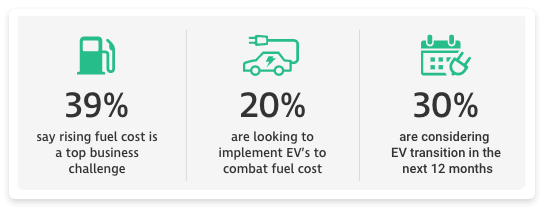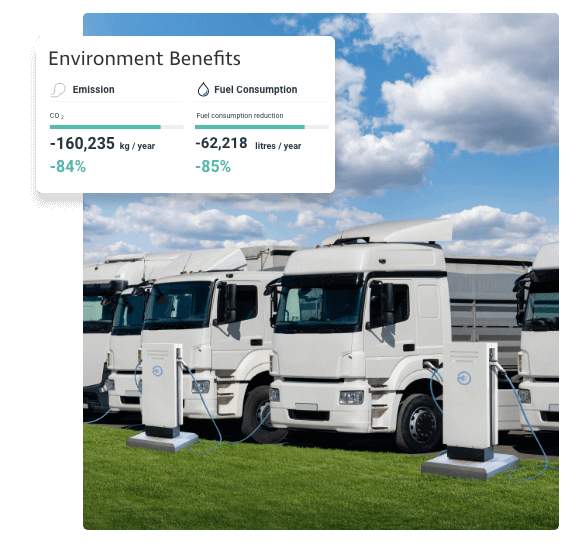Fleet Electrification: How it Will Impact Fleet Management
As diesel and gasoline give way to next-generation fuels, electric vehicles (EVs) and alternative-fuel vehicles are becoming the future for fleet operators. That future is coming quickly, and fleet managers need to understand the impact.
The latest Teletrac Navman Telematics Survey revealed that the top challenge fleet operators are facing is the rising cost of fuel, and among the key initiatives to combat this is a transition to electric vehicles, with 30% of respondents considering electric vehicle transition in the next 12 months.
With so many global businesses considering a transition to electric vehicles, we have put together this guide as an introduction to fleet electrification, explaining what it is, the challenges fleet operators face and how with the help of EV telematics software businesses can plan for an effective transition.

What is Fleet Electrification?
Electrification is the process of transitioning from fossil-fuel-powered vehicles to electric vehicles. By the year 2040, U.S. fleets will operate more than 15 million EVs and in Europe vehicle manufacturers are targeting to stop production of internal combustion passenger vehicles by 2025 and all vehicles by 2030. Governments everywhere are passing laws that will make electrification the standard within the next decade.
So how do you start the transition from fossil fuels to electricity? This can and should be implemented through a phased approach. Here’s what fleet managers need to know as they “end of life” gasoline and diesel-powered vehicles and consider replacing them with more efficient and more economical electric versions. Electric vehicles:
- Require less maintenance and carry a reduced overall cost of ownership
- Meet environmental and other “green” policies by reducing your carbon footprint
- Support environmental, social and governance (ESG) regulations
- Promote a positive brand image
The Long-Term Benefits of Electric Vehicles
The long-term benefits of electric vehicle fleets are established and relatively well-known. EVs are undoubtedly better for the environment than their fossil-fuel counterparts, and with innovative EV battery re-purpose schemes being developed the long-term environmental benefit is going to continue to grow.
But how will a transition to an electric fleet give your business an upper hand? There are four key ways that an electrified fleet can benefit your business:
- Lower operating costs because of electricity’s comparatively low prices
- Lower fleet maintenance costs because EVs have fewer moving components
- Tax rebates and lower tariffs because of one-time and ongoing government incentives
- Improved brand reputation
These benefits hold for any owner, but they’re multiplied across commercial fleets. Companies stand to save potentially four-, five- and six-figure sums (if not more).
The specifics of other next-generation fuels, such as hydrogen and natural gas, are slightly different. These generally also have lower operating, maintenance, and tariff costs, as well, but bring new infrastructure problems.
Because the long-term environmental and sustainability benefits are so great, it’s likely most commercial fleets will transition to electric or another next-generation fuel eventually, with many operating mixed fleets of internal combustion and alternative fuel vehicles for a number of years. The question isn’t if fleets will transition but when and how quickly the transition will occur.
The Short-Term Challenge of Electric Vehicles
Immediate adoption of any next-generation fuel might be slow as supply chain challenges remain a short-term problem. The chip shortage alone has disrupted and slowed EV vehicle production and rising costs of raw materials is also slowing production, but the demand is there from the consumer, with data from the UK showing the battery electrical vehicle registrations have grown by 49% from 2021 to 2022.
A number of leaders from the worlds largest vehicle manufacturers have already raised concerns about how the rising cost of raw materials has already impacted production plans.
Eventually, however, the chip shortage and other short-term supply chain challenges will subside. Electric vehicle adoption, across the board, should steadily accelerate as these vehicles and charging infrastructure becomes more available. More commercial fleets will be among those going electric.
The Longer-Term Challenges of Electric Vehicles
Several longer-term challenges are also present, which will largely dictate which fleets are the first to switch over.
Large Upfront Capital Investment
Switching an entire fleet over to electric vehicles requires a significant capital investment. The investment should more than pay for itself over time, but only the more well-funded will have the financial resources needed to transition
Small businesses and businesses with tight budgets are unlikely to purchase EVs quickly, regardless of what government rebates might or might not be available.
Limited Infrastructure
The lack of infrastructure increases initial costs with many companies needing to build their own charging infrastructure, which can limit the routes on which electric vehicles can be used. Setting up sufficient infrastructure is also difficult in many rural locations.
Infrastructure will likely first build up in cities and along major highways. Correspondingly, businesses that primarily operate within one city or along major road networks are the most likely to transition to electric vehicles in the short term.
Battery Capacity for Commercial Vehicles
The maximum range of the latest electric vehicles is improving with commercial EV manufacturers, such as Tesla, banking on the technology improving relatively fast. Current EV batteries still have a restricted range when used in commercial vehicles, especially when full load weight is factored in. The restricted range can be addressed in cities, where vehicles have relatively easy access to chargers, which means local businesses, last-mile delivery services, and public transportation will be the early adopters.
The risks that limited battery capacity presents are much more severe when traversing long highways. Operational efficiency, vehicle safety, and driver safety are all a consideration if a commercial driver is stranded with no battery power. There is also the challenge of charge time, where minimum charge time on rapid chargers is estimated to be 30 minutes, to achieve 80% charge.

An Example of Fleet Electrification for Buses
The different types of buses illustrate which companies are most likely to use electric vehicles in their fleet:
- Cities may transition their buses to electric first. City buses are never far from depots where chargers could be installed, and buses can be charged at different times since they’re not all in use simultaneously.
- School districts may transition their buses to electric next. School buses still don’t need tremendous range, but they can’t as easily roll buses through charging since school buses typically all drive at the same time of day. Schools thus need more local charging so that most buses can be charged simultaneously.
Coach buses that drive between cities may be the last to go EV. Coach buses need batteries that have plenty of power for longer-distance driving, which is often through more rural areas that have little or no EV infrastructure.
Planning Activities for Fleet Electrification:
Once the decision to move toward electrification has been made, planning the course will be vital. Fleet managers need to consider different criteria when moving toward electrification, including:
- Route management and vehicle usage
- Return on investment (ROI)
- Tax and environmental incentives
- Compliance
- Sustainability goals
- And more
To help ensure your electrification strategy is successful, we’ve compiled this fleet electrification checklist:
Planning
- Driver Training: Review the EV knowledge of your drivers and fleet managers and create the necessary training materials for a successful launch.
- Identify EVSE Opportunities: EV Supply Equipment (EVSE), also known as electric vehicle charging stations, are subject to regulatory scrutiny when used in commercial settings. Make sure you have the proper infrastructure in place to support this new initiative.
- Budget: Budgeting for electrification should include the vehicles and the charging infrastructure. It is important to understand what level of capital improvements will be needed to support the transition?
Design
- Identify Stakeholders: A successful fleet electrification strategy requires buy-in from multiple stakeholders — from executive leadership down to security and maintenance personnel. Identify the key stakeholders and their individual roles and responsibilities.
- Design your Infrastructure: Communicate with your utility provider to ensure your local power grid can support your EV infrastructure.
- Set a Timeline: Various laws have been passed dictating the future of electric vehicles. Government agencies, for example, are required to purchase mostly electric fleets by 2035. California, likewise, has mandated auto dealers stop selling gasoline-powered vehicles by 2035.
Implementation
- Start the purchase process: Purchasing your electric fleet in phases will be the most economical choice. As fossil-fuel vehicles reach their end of life and are ready to be replaced, start introducing EVs.
- Include a Lease Strategy: Purchasing EVs can be expensive. Consider a lease-buy strategy in which some Evs are leased while others are purchased.
- Support Your Drivers: Evs bring new challenges and new stressors on drivers. Understanding these various challenges, including range anxiety, is key to success.
EV Telematics is Essential
Telematics platforms can play a key role in the planning and implementation of an electric fleet. When starting to plan a transition knowing the vehicles that you should change, when and the required charging infrastructure enables you to create a clear plan and understand the capital outlay required. The great news is that the data to understand this is within your telematics platform, and tools like our EV Readiness Tool are designed to do just that.
Once your transition is underway an EV-specific fleet telematics software platform can play a key role in keeping your electric fleet operational by:
- Monitoring individual vehicles’ battery levels in real-time while vehicles are en-route
- Checking before departing whether vehicles are sufficiently charged for their routes
- Prioritizing which vehicles are charged first so that fleet-wide efficiency is maximized
- Monitoring battery capacity trends across individual vehicles and an entire fleet
- Maintaining a high level of driver safety by monitoring the data
With the information that telemetry software provides, fleet managers can address range-related concerns, efficiently manage charging, and reap the benefits of EVs without too many costs.
Should Your Fleet Switch to Electric Now?
Whether now is the right time to switch your company’s fleet over to eclectic is a question that every fleet manager must individually answer. If you’ve recently transitioned or will soon transition vehicles, however, EV telematics fleet software is already available.
With the information that telemetry software provides, fleet managers can address range-related concerns, efficiently manage charging, and reap the benefits of EVs without too many costs.
Should Your Fleet Switch to Electric Now?
Whether now is the right time to switch your company’s fleet over to eclectic is a question that every fleet manager must individually answer. If you’ve recently transitioned or will soon transition vehicles, however, EV telematics fleet software is already available.


